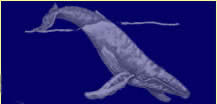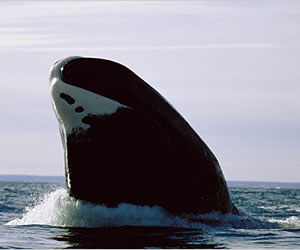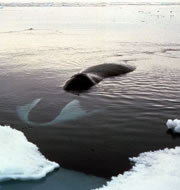 |
Alaska whale watching tours allow the visitors an opportunity to observe and photograph Humpback, Orca, Gray, and Beluga whales, along with many other marine mammals, in their natural environment. |
 |
Captains Choice Whale-Watching-Alaska.com |
 |
Contact Us At: |
 |
|
 |
|
Bowhead Whales in Alaska.
They hold their mouth open as they swim through the water, letting the water flow through the baleen until krill, zooplankton and copepods (a group of small crustaceans) become trapped; then they close their mouth and swallow them. Because of their enormous size, they must eat up to two tons of food each day. Bowhead whales live near pack ice, often in shallow water. Their two-foot layer of blubber protects them from the freezing waters. The southwest Bering Sea is their wintering grounds. In early April and all of May they swim past Saint Lawrence Island through the Chukchi Sea near Kivalina, Point Hope, Wainwright and Barrow Alaska. The migration patterns of the bowhead whale are still being studied. Beluga whales often swim with them as they migrate north to their summer feeding grounds. They quickly dive under the water when they are alarmed. These whales have excellent vision and hearing. They are rarely seen in pods and are usually alone. When they move south in the fall there may be as many as fifty whales swimming together. Killer whales may attack bowheads but humans are their main predator. The north pacific bowheads are now increasing in numbers, more than 8,000 animals. Whalers used to hunt them for their oil and baleen. These whales continue to be threatened by loss of food sources, climate changes, noise and pollution. Today, Eskimos hunt an allocated number of these whales each year for oil and food. Bowhead whales make sounds while moving under the ice, which are
used to find their way around in the dark. They do not use sonar
(echolocation) to find food but have been heard singing, calling
back and forth to each other. Killer Whales, Orca.
Common names: Bowhead Whale, Great Polar Whale
or Greenland Right Whale Length: 45-60 feet with a maximum length of 65
feet. Travel speeds: up to 12 miles per hour with average
speeds of 2-7 miles per hour. Conservation Status: U.S. protection under the
Endangered Species Act and Marine Mammal Protection Act. International
Whaling Commission outlawed whaling of bowheads in 1946. Whale Watching Alaska | Whale Watching | Whales in Alaska | Whale Watching Tours | Killer Whales Here on Whale Watching Alaska you will find information on Alaska whale populations, distributions and over all health. gray whale, killer whale, humpback whale, beluga Experience Juneau, Alaska Whale Watching trips and tours and discover the difference. Personalized whale watching tour. 1 to 6 passengers. This is your Alaska tour, done your way. See a large selection of quality Alaskan whale watching trips in Juneau, a leading one stop tour operator for adventure and exceptional Alaska travel. Numbers obtained from the Alaska Dept. of Fish and Game. |
 Bowhead whales received their name because of their high, arched
lower jaw that looks like the archer's bow. They are dark black,
brown or gray in color with white spots on their chin and belly.
These giant whales use their large triangular shaped heads as a
battering ram to break through 2 feet of ice to breathe. Bowhead
whales are a member of the baleen whale family, having baleen plates
instead of teeth. These baleen plates may reach up to 12 feet making
them the largest of any whale species.
Bowhead whales received their name because of their high, arched
lower jaw that looks like the archer's bow. They are dark black,
brown or gray in color with white spots on their chin and belly.
These giant whales use their large triangular shaped heads as a
battering ram to break through 2 feet of ice to breathe. Bowhead
whales are a member of the baleen whale family, having baleen plates
instead of teeth. These baleen plates may reach up to 12 feet making
them the largest of any whale species.  The orca or killer whale is readily identified. With it's pointed
dorsal fin of up to 6 feet tall and shinny black and white white
bodies typically sporting a white patch behind the eyes.
The orca or killer whale is readily identified. With it's pointed
dorsal fin of up to 6 feet tall and shinny black and white white
bodies typically sporting a white patch behind the eyes.